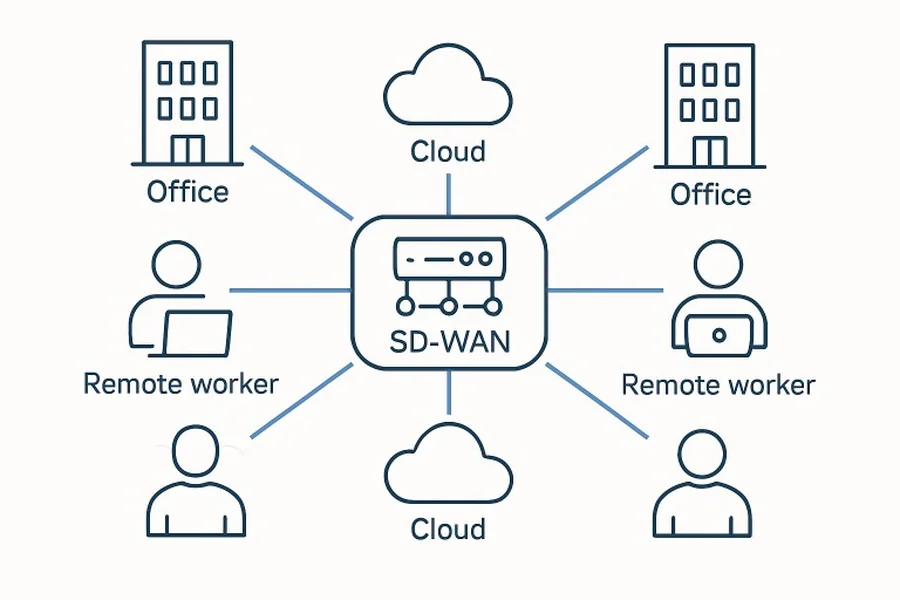As digital transformation accelerates across industries, enterprises face mounting demands for faster, more resilient, and more secure connectivity. Conventional wide area networks (WANs) often struggle to keep pace with the dynamic needs of distributed workforces and cloud-first strategies. SD WAN managed service provider solutions are empowering organizations to modernize their network infrastructure, provide enhanced security, and streamline operations.
Software-Defined Wide Area Networking (SD-WAN) is increasingly recognized as the backbone of agile enterprises aiming to drive digital business outcomes. Through intelligent traffic management and seamless integration of multiple connection types, SD-WAN helps businesses optimally connect headquarters, branches, cloud resources, and remote users—all while managing costs and improving the user experience.
The evolution toward software-based networking is not just a technical upgrade—it’s a strategic enabler. With IT teams now tasked with supporting global operations, hybrid work, and cloud-based applications, adopting SD-WAN infrastructure can help enterprises achieve their security goals, enhance operational efficiency, and future-proof their networks.
By decoupling network management from underlying hardware and leveraging policy-driven automation, SD-WAN solutions enable enterprises to adapt to market shifts quickly. As we explore the advantages of SD-WAN, best practices for implementation, and next-generation trends, it becomes clear why leading organizations are embracing this technology to gain a competitive edge.
What Is SD-WAN?
SD-WAN is a technology solution that transforms traditional WAN architectures by abstracting network control into a centralized management platform. Instead of relying exclusively on expensive, rigid connections like MPLS circuits, SD-WAN utilizes software intelligence to direct traffic over a combination of broadband, LTE, and legacy infrastructure. This dynamic approach enables the network to route mission-critical applications over the most optimal paths based on current conditions, thereby enhancing performance and reliability.
Centralized orchestration also means that IT teams can manage security, application prioritization, and bandwidth allocation in real-time—across all locations—from a single interface. As a result, enterprises gain greater control and responsiveness than ever experienced with legacy WANs. According to Cisco, SD-WAN can reduce downtimes and improve business agility, both critical factors in today’s always-on business environment.
Key Benefits of SD-WAN
- Cost Efficiency: By blending affordable broadband and mobile connections with existing WAN infrastructure, organizations can significantly cut operational costs.
- Performance Optimization: SD-WAN’s intelligent traffic steering automatically prioritizes applications based on need, enhancing end-user experience for cloud apps, VoIP, video, and more.
- Enhanced Security: End-to-end encryption, next-generation firewall integration, and secure segmentation help protect enterprise data in transit, regardless of the location from which it is accessed.
- Rapid Scalability: Expanding to new sites or supporting more users is streamlined, with minimal need for additional on-site hardware or complex configuration.
- Simplified Management: Centralized controllers provide admins with a holistic view, enabling seamless deployment of policies and troubleshooting.
Implementing SD-WAN in Your Organization
1. Assess Existing Network Infrastructure
Begin by auditing your current WAN setup to identify bottlenecks, recurring outages, and key locations that would benefit most from an SD-WAN overlay. Look for compatibility issues and create an inventory of all network endpoints.
2. Define Business Objectives
Establish clear goals for the SD-WAN rollout, such as lowering branch connectivity costs, increasing resilience, improving access to cloud applications, or implementing uniform security.
3. Select the Right SD-WAN Solution
Not all SD-WAN offerings are created equal. Evaluate potential solutions based on their ability to integrate with existing investments, their security features, and their support for application optimization. Leading options come with detailed analytics, easy policy management, and strong vendor support.
4. Plan and Roll Out Deployment
Design a phased deployment strategy, starting with pilot locations before a full-scale rollout. Prioritize sites based on criticality, risk, and operational requirements. Test integration points and train IT staff on new workflows.
5. Continuous Monitoring and Optimization
Use SD-WAN’s analytics to monitor usage, application performance, and security events. Policy adjustments and proactive maintenance ensure the network remains aligned with evolving business needs.
Real-World Examples of SD-WAN Adoption
Enterprises of all sizes have reaped significant benefits from SD-WAN. For example, a top-tier logistics provider implemented SD-WAN at 3,000+ global locations, cutting application downtime by 35% and improving real-time supply chain visibility. In another case, a major financial institution standardized its branch connectivity on secure SD-WAN, reducing new branch onboarding time by 25% while maintaining compliance and consistent policy enforcement.
The healthcare sector has also adopted SD-WAN, utilizing it to deliver fast and secure access to cloud-based health records for clinics and mobile caregivers, thereby enhancing both security and patient care. A recent report by Forbes states that widespread SD-WAN adoption is enabling companies to simplify operations even as networks become more complex.
Future Trends in SD-WAN
- SASE Integration: The Secure Access Service Edge (SASE) framework converges SD-WAN with robust security services, including CASB, SWG, and zero-trust access, to create holistic, cloud-delivered networking environments.
- AI and Machine Learning: AI-driven analytics are being incorporated for predictive network management, proactive threat response, and smarter traffic optimization.
- 5G Network Adoption: The rollout of 5G is accelerating SD-WAN’s capabilities, offering unprecedented bandwidth and ultra-low latency for branch and remote connectivity. According to Network World, organizations that leverage SD-WAN and 5G together can scale their operations and improve mobility dramatically.
Conclusion
SD-WAN networks are redefining the way enterprises build connectivity in the digital age. With powerful benefits like cost efficiency, performance optimization, and robust security, SD-WAN is fast becoming the default route for companies seeking agility and resilience. By following best practices for implementation and staying ahead of future trends, organizations can ensure that their networks are ready for whatever challenges and opportunities lie ahead.







